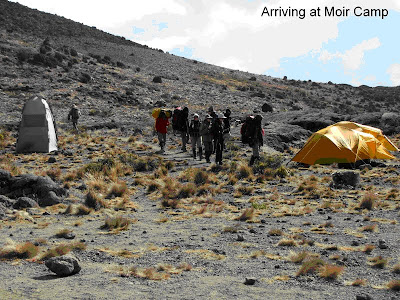Hans awoke at 9 out of 10 and was feeling much better. The scale out of 10 is a practice of Tusker to monitor the health of their clients during the climb. Twice a day they asked the following questions:
1. On a scale from 1 to 10, with 10 being great, how do you feel?
2. How is your breathing?
3. Have you had a pee in the last 2 hours?
4. Have you had a bowel movement in the last 24 hours?
5. Do you have a head ache?
6. Are you nauseous?
7. How is your appetite?
8. Have you taken your Diamox (for altitude)?
9. Have you taken your Malerone (for malaria)?
There was a group medical check in the evening, usually before dinner and a private medical check in the morning when one of the guides would listen to you breathing with a stethoscope. This protocol, combined with High Altitude First Responder training for the three guides, was very reassuring. David, Chief of Surgery in the biggest hospital in eastern Canada, was very impressed with the process and the guides’ level of knowledge. So Hans being a 9 really meant something to all of us.
Our climb would begin with the Baranco Wall, the closest we would come to technical climbing on this expedition. The wall is 600 vertical feet and, if you include the slopes at the base and summit, it’s 800 feet in total. Would the entire team be able to scale this wall without succumbing to acrophobia?


One of the amazing things about climbing is that when you're in an exposed position your world contracts to the space that's 3 - 15 away from you. You think about the the next hand hold or foot placement, not the fact that if you look down it's 500 ft to the valley floor. So, not only did the group scale the wall in a bit over an hour, they had fun doing it. In fact, many people said that it was one of the most enjoyable parts of the trip.
After scaling the wall, we had a short hike to Karanga Camp, or so we thought. We could see Karanga and and Kombe, our head guide gave the guys a quick test. How far to Karanga? Our answers ranged from 7 - 20 minutes. Wrong! There was a ravine of 500 vertical ft between us and the camp, so the correct answer was 1.5 hours. We arrived in Karanga after 5 hours and 15 minutes of climbing.
We would have cell phone coverage again, so many of us touched base with home. We would also be staying two nights in Karanga. The next day we would do an acclimatization climb, almost to Barafu, our next camp and return to Karanga for sleeping. Climb high, sleep low. This was always our plan and it is why we choose the longest route to get to the summit.
We enjoyed a hot lunch and then had the afternoon free. The clouds cleared and the sun came out. We had been on the mountain for 5 days and the ladies deserved a bit of pampering so they set up the beauty salon at 13,200 ft.


















































